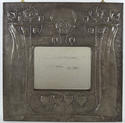 Margaret Macdonald Mackintosh (1864-1933) was an artist whose design work became one of the defining features of the "Glasgow Style" during the 1890s. Born Margaret Macdonald, near Wolverhampton, her father was a colliery manager and engineer. By 1890 the family had settled in Glasgow and Margaret and her sister Frances (1873-1921) enrolled as students in the city's Art School. Under the direction of Francis H Newbery (1853-1946) the School had acquired a progressive reputation, particularly for encouraging female talent.
Margaret Macdonald Mackintosh (1864-1933) was an artist whose design work became one of the defining features of the "Glasgow Style" during the 1890s. Born Margaret Macdonald, near Wolverhampton, her father was a colliery manager and engineer. By 1890 the family had settled in Glasgow and Margaret and her sister Frances (1873-1921) enrolled as students in the city's Art School. Under the direction of Francis H Newbery (1853-1946) the School had acquired a progressive reputation, particularly for encouraging female talent.
 The Macdonald style was distinguished by its sinuous and elongated contours and was heavily imbued with symbolism. Margaret Macdonald was intrigued by the esoteric mysticism fashionable among the artistic avant-garde and used elements from a range of spiritually charged sources, including Egyptian and Celtic influences, to create her compelling designs. Her style was not to everybody's taste and in the early years was dismissed as the "Spook School" because of her predilection to depict the human form as unnaturally wraith-like.
The Macdonald style was distinguished by its sinuous and elongated contours and was heavily imbued with symbolism. Margaret Macdonald was intrigued by the esoteric mysticism fashionable among the artistic avant-garde and used elements from a range of spiritually charged sources, including Egyptian and Celtic influences, to create her compelling designs. Her style was not to everybody's taste and in the early years was dismissed as the "Spook School" because of her predilection to depict the human form as unnaturally wraith-like.
 Yet while Macdonald delved deep into history for inspiration, she was also experimental. She worked in a range of media, including watercolour, graphics, metalwork and textiles. Her decorative skills and spiritual intensity were crucial to the success of the working partnership that she formed with the architect Charles Rennie Mackintosh (1868-1928) whom she married in 1900. Her influence is apparent in some of the most celebrated Mackintosh interiors, such as the Sauchiehall Street Willow Tea Rooms, opened in 1903. Mackintosh reputedly said of his wife, "I had talent, Margaret had genius". However, their success was short-lived and by 1914 commissions for work were diminishing. That year the Mackintoshes left Glasgow and both eventually died in London.
Yet while Macdonald delved deep into history for inspiration, she was also experimental. She worked in a range of media, including watercolour, graphics, metalwork and textiles. Her decorative skills and spiritual intensity were crucial to the success of the working partnership that she formed with the architect Charles Rennie Mackintosh (1868-1928) whom she married in 1900. Her influence is apparent in some of the most celebrated Mackintosh interiors, such as the Sauchiehall Street Willow Tea Rooms, opened in 1903. Mackintosh reputedly said of his wife, "I had talent, Margaret had genius". However, their success was short-lived and by 1914 commissions for work were diminishing. That year the Mackintoshes left Glasgow and both eventually died in London.